What Is a Marketing Campaign?
A marketing campaign is a set of carefully planned activities with a clear goal, such as product promotion, audience education, or brand awareness.
Some campaigns run on a single platform, such as Instagram or TV. But more often, a business marketing campaign runs on multiple platforms simultaneously geared toward one or more shared goals.
For example, if you run a Black Friday promotion on your ecommerce site, you can use social media to grow your reach and drive traffic.
At the same time, you can send out a series of emails to inform your subscribers about it. There’s also the option to partner with influencers or launch an advertising campaign to get more eyes on your products.
Different Types of Marketing Campaigns
Marketing campaigns fall into different categories based on their objectives, target audience, distribution channels, duration, and the regions they target.
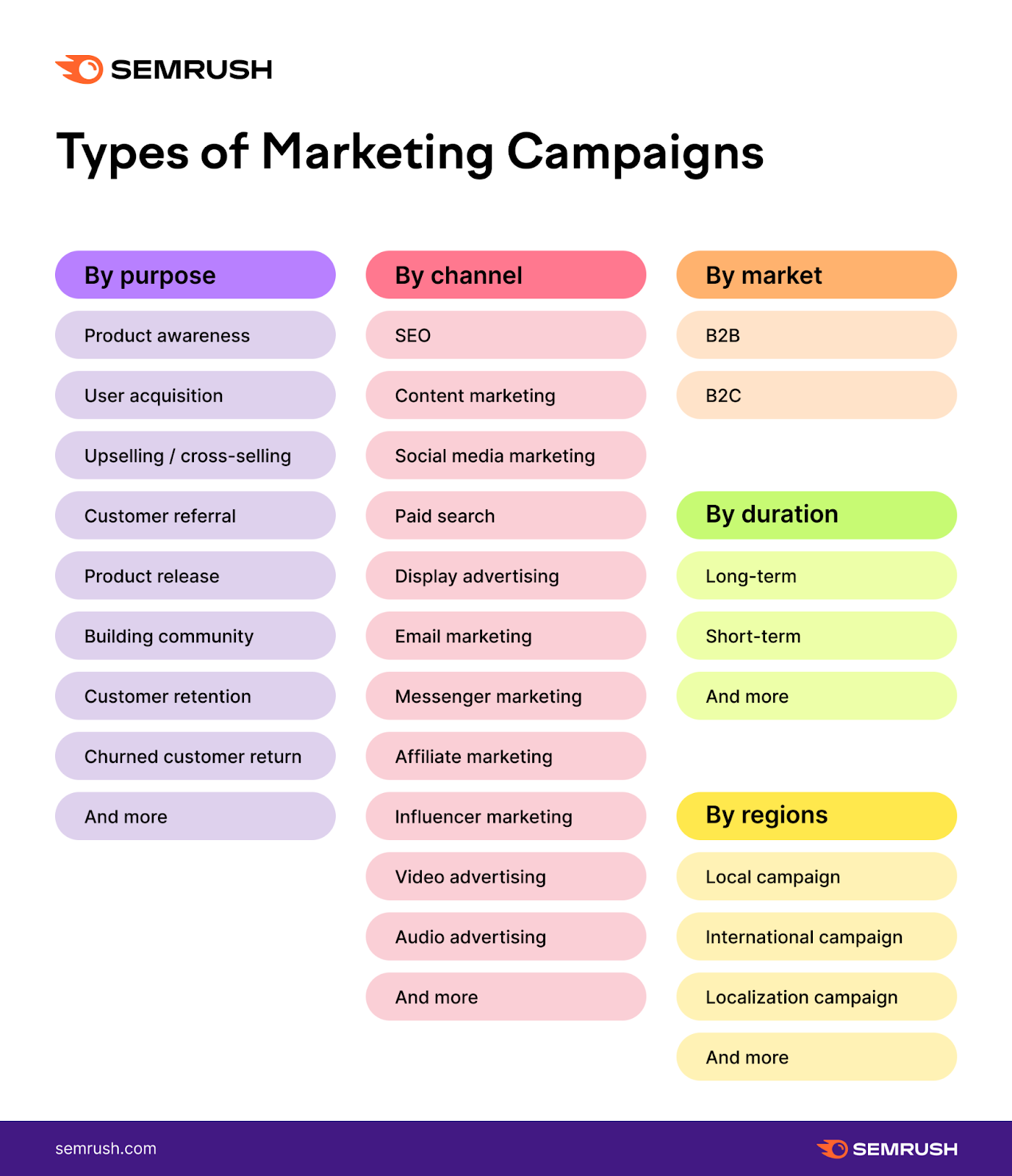
By Purpose
All marketing campaigns have one or more primary goals, such as increasing sales, boosting brand awareness, or driving customer loyalty.
However, some of them have more specific objectives, like:
- Product awareness campaigns: Generate exposure and recognition for an existing product or an upcoming product release
Example: A fashion brand teams up with bloggers and influencers to promote a new clothing line - Community campaigns: Build a sense of belonging among customers to create a loyal community around a brand or product to lead to higher engagement and repeat sales
Example: A marketing agency can hold regular meetings, seminars, or Q&A sessions on Zoom. Customers who participate in these meetings may provide feedback, ask questions, exchange opinions, and gain insights. - Upselling/cross-selling campaigns: Promoting additional or complementary products to existing customers to increase order value
Example: Let’s say you sell sports equipment online. When someone is ready to order a gym bag, you’ll recommend related products, such as training gloves or shaker bottles - Customer retention campaigns: Implement strategies to keep existing customers engaged, satisfied, and loyal to the brand
Example: Send personalized thank-you emails featuring exclusive discounts to buyers who make a purchase - Customer referral campaigns: Encourage satisfied customers to recommend your products to their family and friends through word-of-mouth or referral programs
Example: Launch a referral program that rewards existing buyers with discounts for each friend they refer (assuming that person ends up purchasing a product from your site) - User acquisition campaigns: Attract new users or customers to a product or service through targeted marketing initiatives
Example: A software development company launches an advertising campaign on Facebook or LinkedIn to reach a larger audience
By Channel
- SEO campaign: Optimize a website to improve its visibility in organic search engine results
- Content marketing campaign: Create, optimize, publish, and distribute relevant content online to attract and engage customers
- Social media marketing campaign: Leverage social platforms to promote products or services, build brand awareness, and engage your target audience
- Email marketing campaign: Send targeted emails to a group of people to nurture relationships, drive engagement, and encourage conversions
- Traditional media campaign: Use conventional marketing channels, such as TV, radio, and print, to promote a product or service
- Advertising campaigns: Market your products or services through paid channels like Google ads, TikTok ads, Meta ads, or traditional advertisements to reach a wider audience
- Influencer marketing: Collaborate with people who have a significant online following to promote your brand or products
- Referral/affiliate marketing: Encourage your customers to refer others, or partner with affiliates to drive sales through commission-based incentives
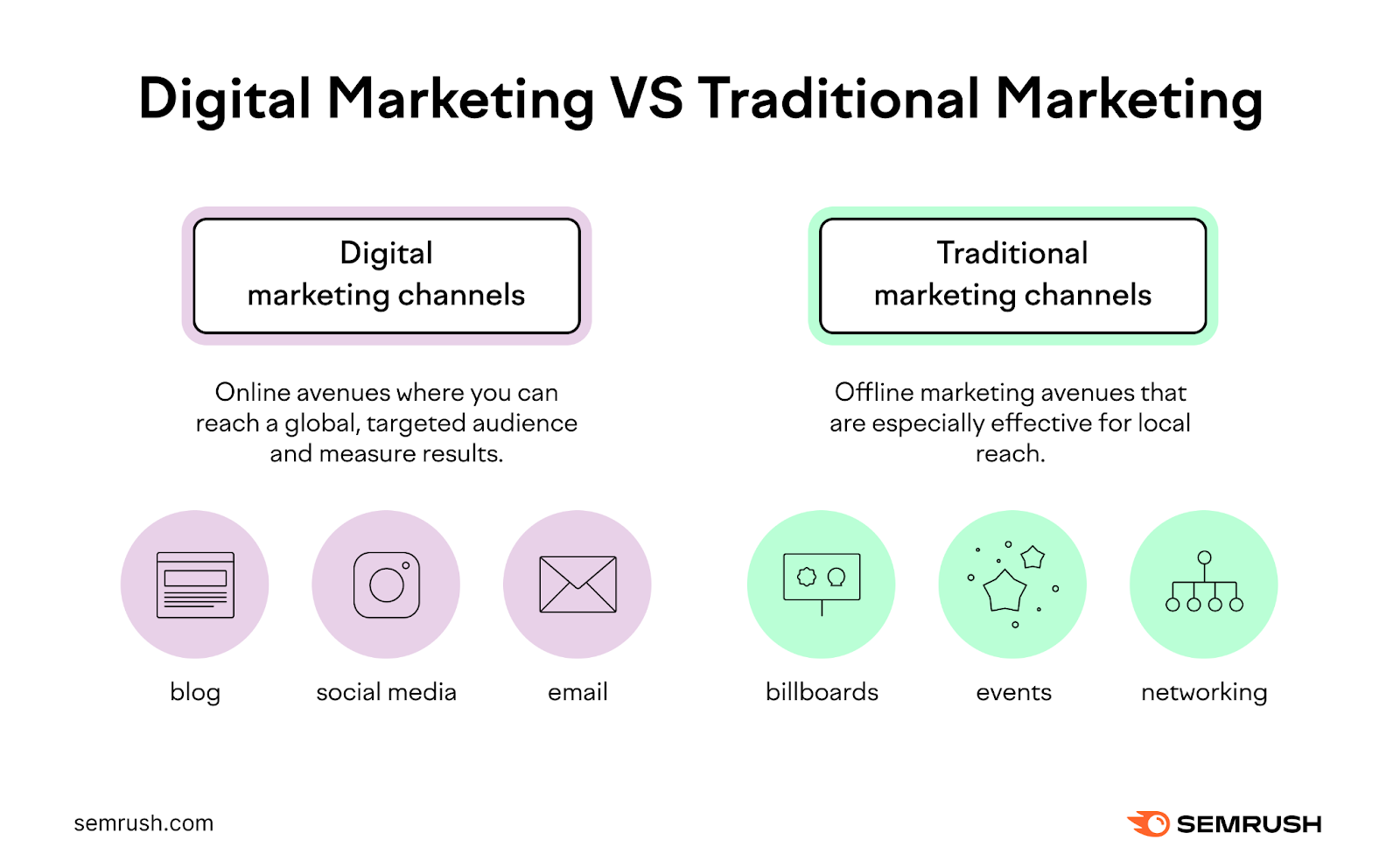
By Market
- Business-to-business (B2B) campaigns: Promote your products or services directly to other companies. An example is an apparel wholesaler marketing its products to department stores and other fashion retailers.
- Business-to-consumer (B2C) campaigns: Target your end consumers. For example, Zappos and Gymshark sell their products to individuals, not businesses.
By Duration
- Long-term campaigns: These campaigns focus on building lasting relationships with customers and keeping them engaged with your brand.
Example: Dove’s Real Beauty campaign has lasted for years and is still running. It has defined the brand as focusing on evergreen values that will always be relevant, such as celebrating women of every skin color and type. - Short-term campaigns: These aim to achieve immediate goals, such as driving sales during the holidays, creating urgency around a purchase, or capitalizing on specific events.
Example: Many online brands offer discounts on Black Friday and Cyber Monday, as these are some of the biggest sales days of the year. Because Black Friday campaigns are seasonal, they only run for a limited period.
By Region
- International marketing campaigns: Brand activities that appeal to a global audience.
Example: Dove's Real Beauty campaign showcases women from different countries to celebrate their beauty and differences. It was a hit and increased the company’s sales from $2.5 billion in 2004 to $4 billion in 2014. - Local marketing campaigns: With this approach, you’ll focus your marketing efforts on a local community or specific city or state
Example: The "Buy two, get one free" deal at your local pizza place. - Localization campaigns: Adjust your marketing messaging based on the cultural sensibilities and preferences of the target market.
Example: Netflix’s YouTube campaign for Indian audiences features Indian comics who review and promote the company’s movies and series.
Examples of Marketing Campaigns with Successful Outcomes
Barbie (2023)
Barbie’s creativity and omni-channel execution caused many marketing experts to stop and take notice. The movie generated $162 million in its opening weekend alone.
Campaign goal: Promote the film and generate widespread excitement to increase ticket sales.
How they did it: Barbie’s promotional campaign used platforms like Instagram, Facebook, TikTok, and X (formerly known as Twitter) to engage a worldwide audience with behind-the-scenes content, trailers, and a unique selfie generator.
Collaborations with brands like Airbnb, Forever 21, and Burger King expanded Barbie's reach across various industries.
They each used a specific shade of pink, the color that has become unmistakably associated with the Barbie brand over the years, to promote branded merchandise.
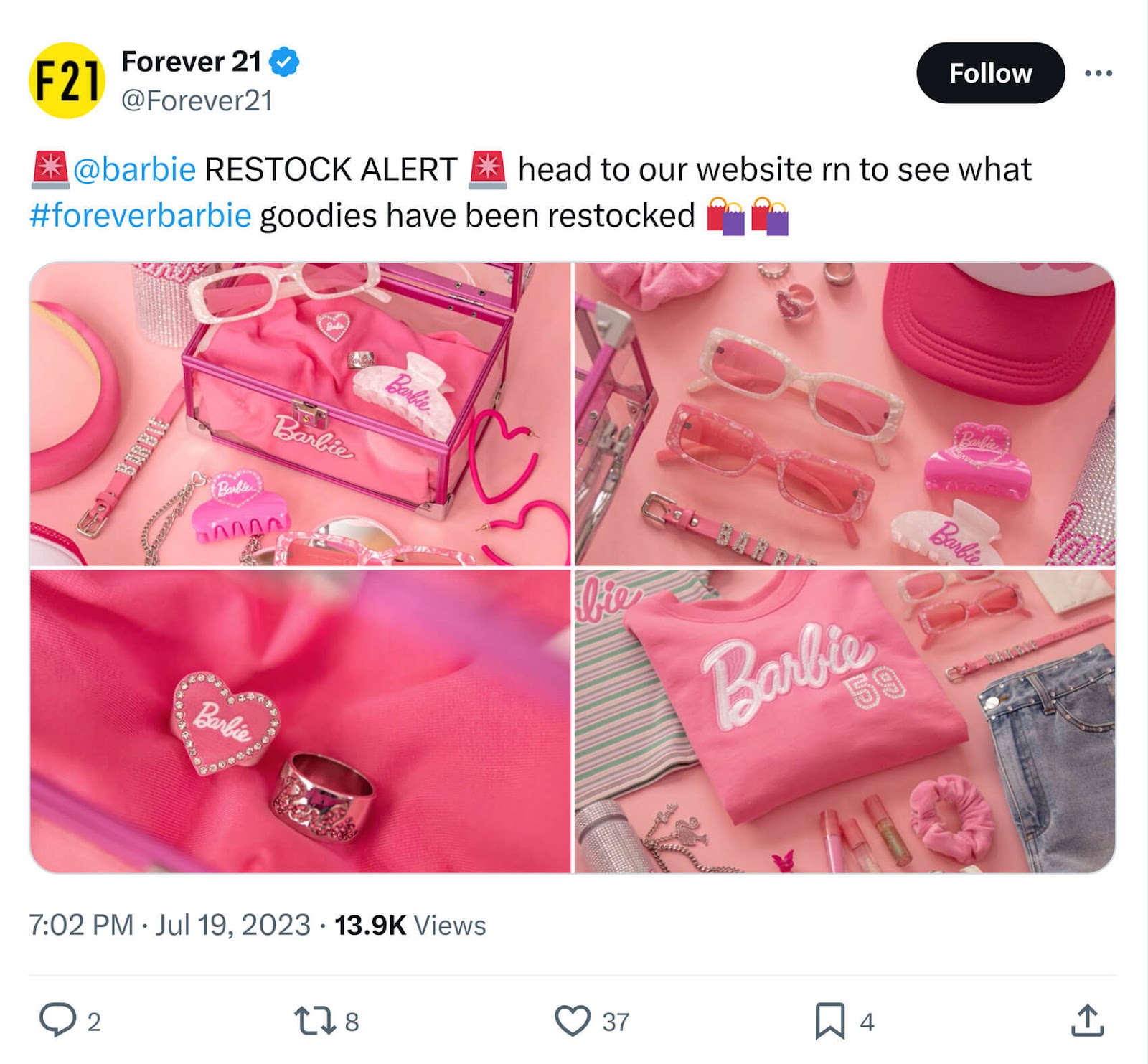
By partnering with industry leaders in fashion, travel, and food, Barbie's marketing team was able to engage diverse audiences.
What we can learn from their strategy: The elements that made Barbie so popular on social media were bold tactics like a 3D video of a giant Barbie projected near Burj Khalifa. The key takeaway is to create unique, bold content that can go viral on social media and partner with other brands to expand your reach.
Carlsberg’s “Adopt a Keg” Campaign (2020)
During the Covid-19 lockdown, many bars and pubs suffered huge revenue losses due to closures.
Carlsberg’s Adopt a Keg campaign drew customers’ attention to this problem in Malaysia. Its goal was to encourage them to adopt a keg in their neighborhood bar to help local businesses stay afloat. This keg would be available for them to enjoy with friends after the lockdown.
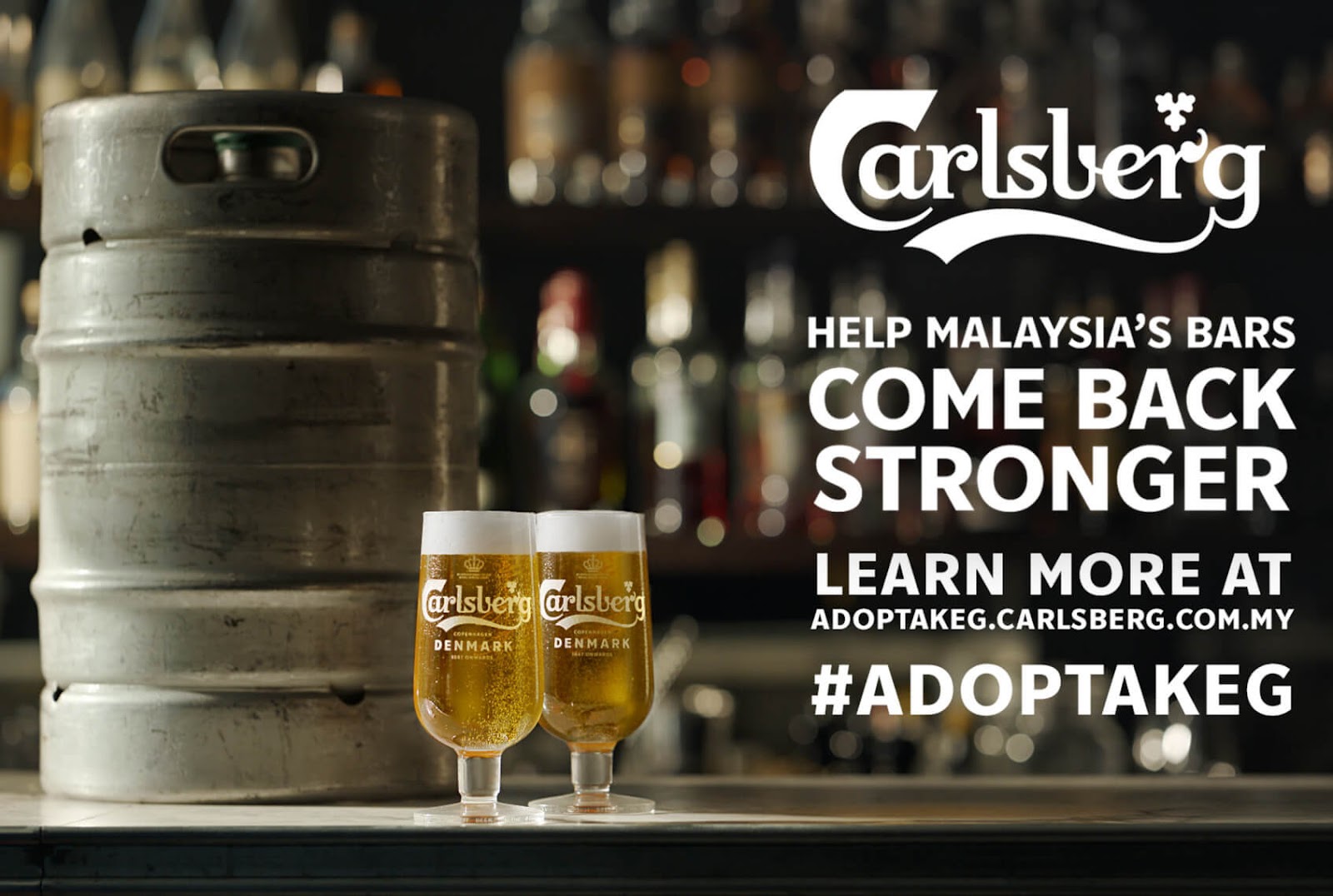
One thousand customers signed up in three days. The campaign was such a resounding success that Carlsberg had to pause it within three weeks because all kegs had been successfully adopted.
Campaign Goal: Encourage Malaysians to help struggling bars during the Covid-19 pandemic.
How they did it: Carlsberg used social media channels to create awareness around the campaign. Participating bars rewarded those who adopted a keg during the lockdown with two free beers, in addition to the keg. This incentive helped build excitement around the campaign.
What we can learn from their strategy: Carlsberg knew traditional advertisements wouldn't be effective when people were mostly indoors. So, it launched the entire campaign online. The lesson is to know where your content will be most effective, and take advantage of it.
Airbnb’s “Made Possible by Hosts” Campaign (2021)
In 2021, Airbnb launched a global ad campaign to tap into travelers' pent-up desires to explore the world.
Airbnb hosts and the brand suffered revenue losses due to travel restrictions. Many countries began loosening travel restrictions, which presented an opportunity.
The company got local hosts worldwide to create user-generated content (UGC) to show how they make traveling with Airbnb special.
The campaign content got 17 million views across all platforms and 10x more engagement on Facebook than Airbnb’s other marketing content.

Campaign goal: To remind people that traveling is rewarding, and Airbnb hosts can make it even more so.
How they did it: Airbnb realized how important UGC is. According to one survey, consumers find UGC more authentic than branded content
What we can learn from it: Their campaign makes a strong case for using UGC. This type of content often feels more genuine than ads or product reviews, helping build trust. In some cases, it may serve as social proof.
Airbnb’s campaign also highlighted the importance of tapping into audience pain points (missing travel experiences) and launching campaigns at the right time.
How to Build an Effective Marketing Campaign
Think of creating a marketing campaign like planning a trip.
First, you need to know where you are going (the purpose).
Then, you need to figure out the logistics: how are you going to get there (channels required), what will it cost (the budget), who you'll go with (the team who’ll work on a campaign), and what you'll visit when you get there.
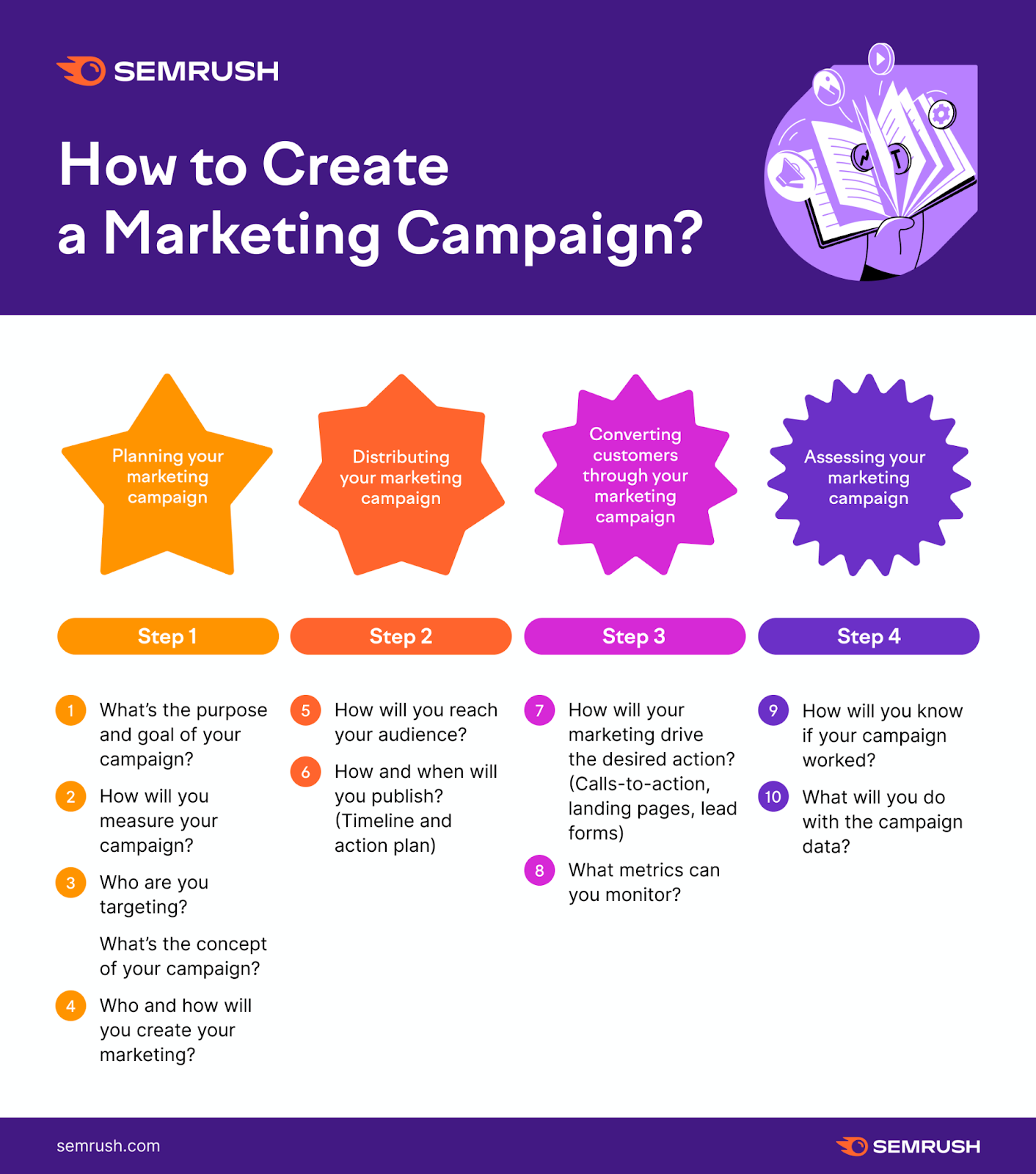
Further reading: Your Marketing Process Guide: 5 Key Parts
Key Components of Digital Marketing Campaigns
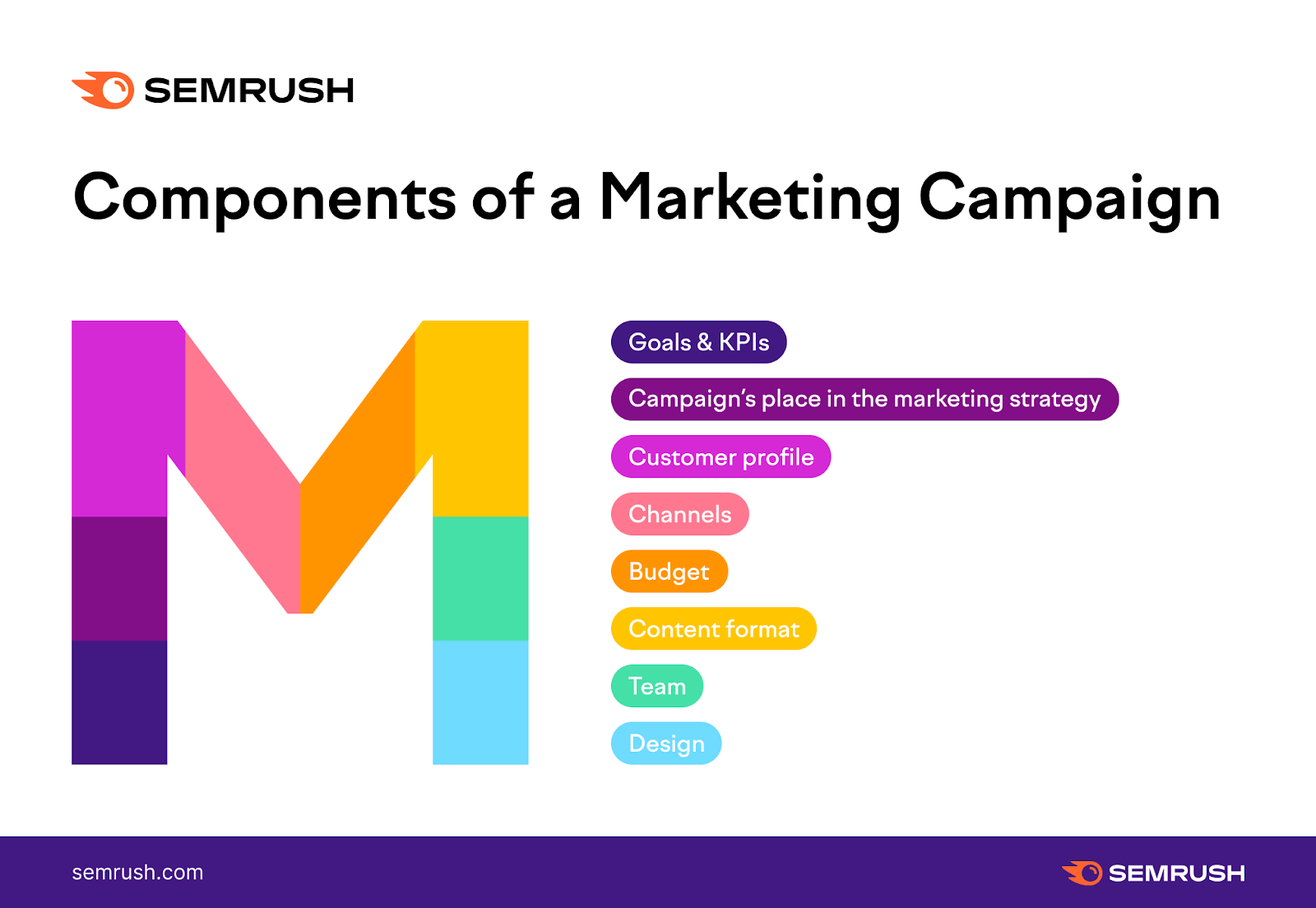
Continuing with the trip analogy, you’ll need to identify the following to execute a marketing campaign:
- Where you want to go (goals and KPIs): Set clear goals so you have a clear idea of what activities to focus on. Also, choose relevant KPIs to track your progress toward those goals.
- Why you want to get there (purpose): So you know why the campaign is necessary and how it fits into your overall digital marketing strategy. At any given time, you can run more than one type of campaign—knowing what role a particular one will play can help you coordinate your marketing efforts.
- Who do you want to connect with along the way (target audience): So you can tailor the campaign to your ideal customers’ preferences and identify the best channels to reach them
- How you will get to destination (channels): So you can connect with the intended target audience in the right place, at the right time.
- How much it’ll cost to get there (campaign budget): Every business decision has to make sense in terms of return on investment (ROI). Without knowing your marketing budget, you can’t determine whether the campaign makes financial sense.
- What to pack for your trip (content format): Different types of content resonate with different audiences, and certain formats may work better on some platforms than others.
- Who will help you get there (team): Knowing who will handle different parts of the project can help you estimate the bandwidth of the campaign, associated costs, and timelines
- How you’ll pack your belongings (design): How you present your content can attract or deter potential customers. Package it in a way that resonates with the target audience.
1. Perform In-Depth Market Research
Learn everything you can about your target market to create a campaign that’s both memorable and profitable.
Focus on these aspects:
- Market size: Determine the audience's size for a product or service. If the product is too niche, it might not be a profitable campaign.
- Market dynamics: How easy is it to break into the market? Identify any broad cultural, economic, or social factors that can affect your campaign's performance.
- Target audience: Analyze your customers' demographics, behaviors, and preferences to tailor the campaign messaging and strategies
- Competitive landscape: Compare your brand to your competitors to identify market gaps, assess your brand’s strengths and weaknesses, and understand what sets it apart. This will help position your brand as unique.
Use Semrush’s Market Explorer tool to research your target market and the competitive landscape.
Go to “Market Explorer” under “Trends” and navigate to the “Analyze Category” tab.
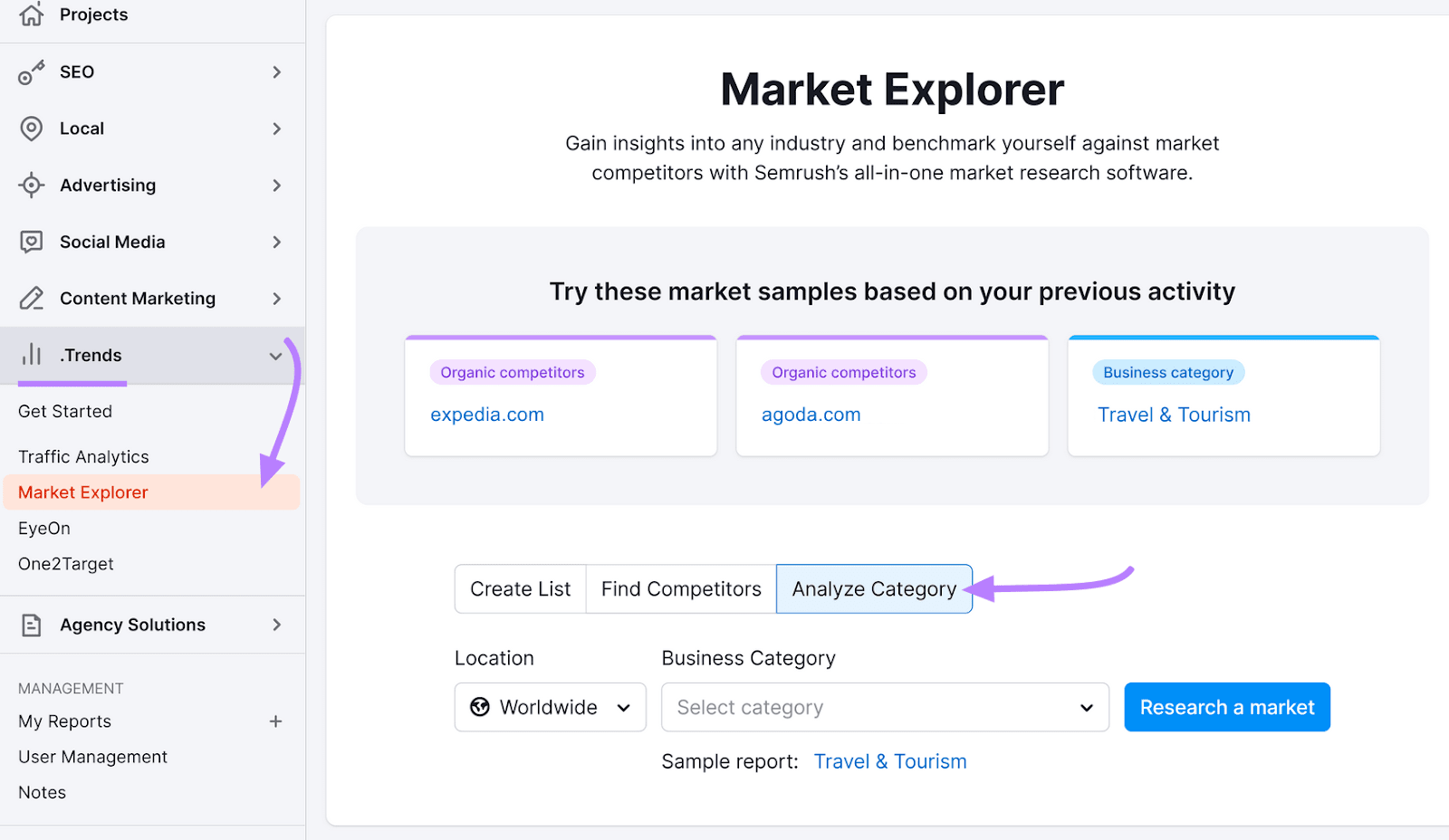
Now, select the industry and location you want to target from the drop-down menus. Then, click the “Research a market” button.

You’ll be taken to the “Overview.” Here you can see how much traffic other websites in your industry receive and the market's total size.
There’s also a section called “Market Consolidation.” In this context, consolidation is a measurement of market distribution.
Low market consolidation means the market share is distributed among a large number of players. High consolidation indicates that only a few players own the majority of the market.
The travel and tourism market has a low level of consolidation, which can make it difficult for newcomers to break into the industry.
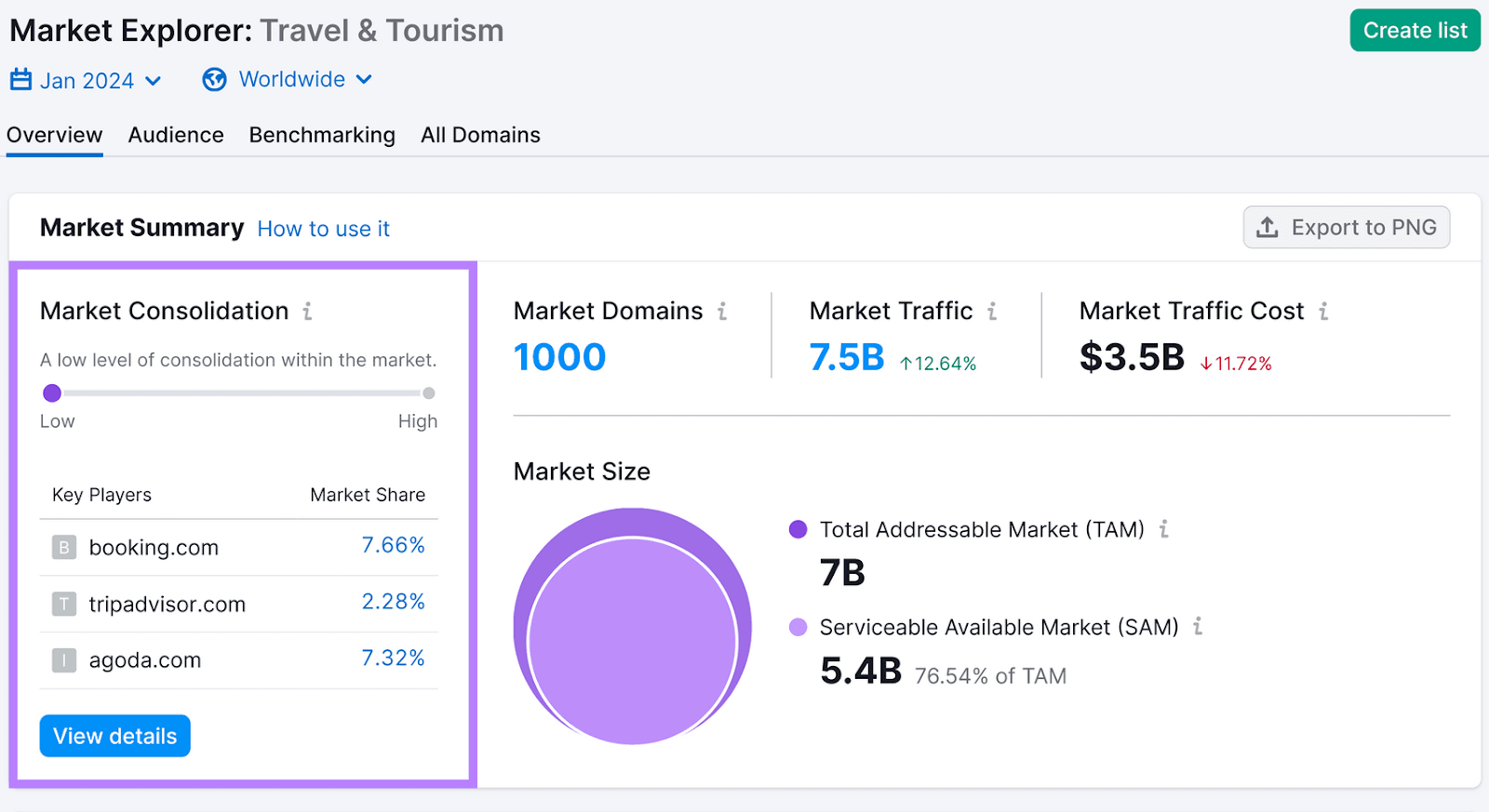
Next, navigate to the “Audience” tab from the top bar.
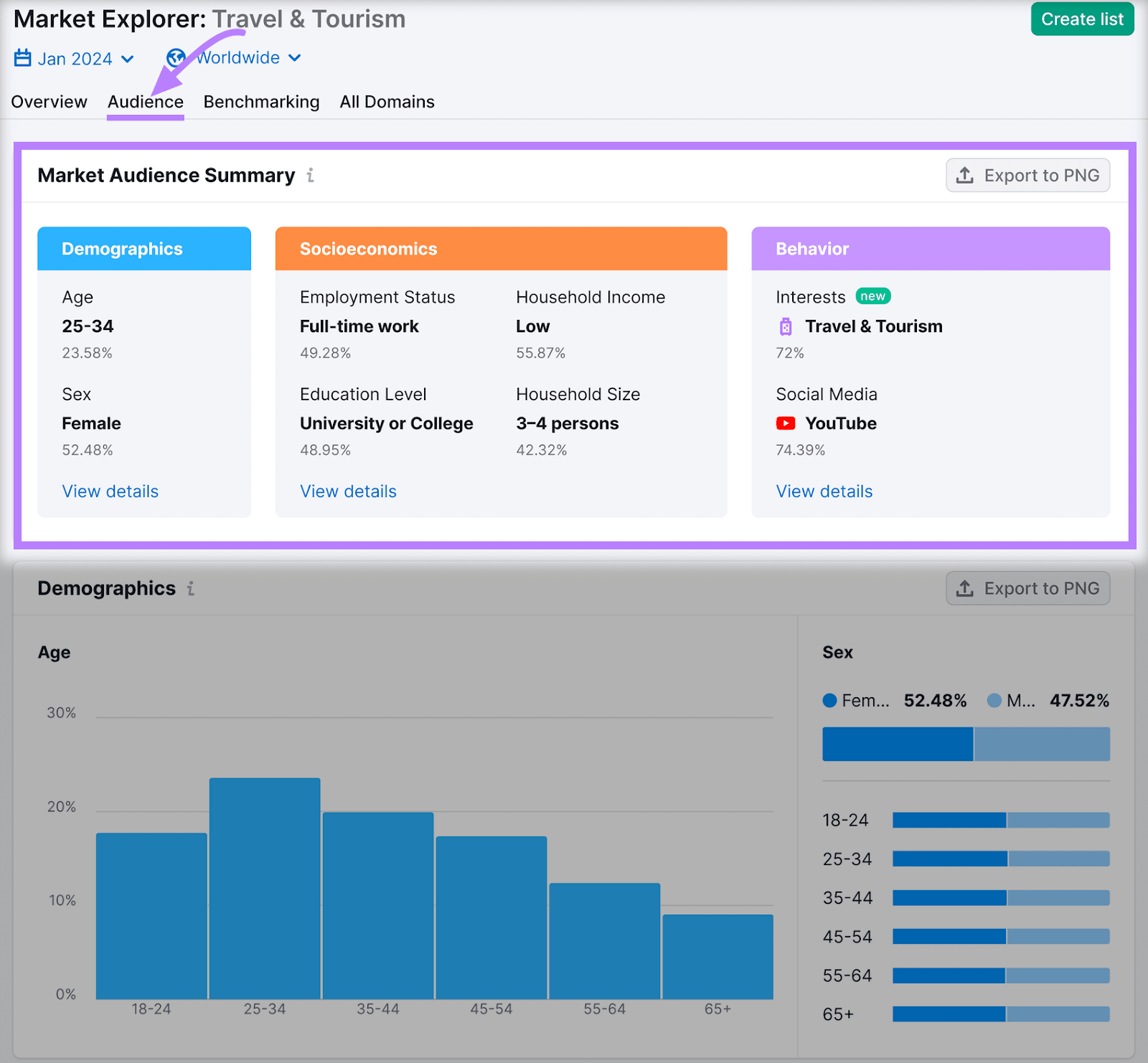
Here, view your target audience’s demographic information.
This includes:
- Age and sex
- Social media preferences
- Interests
- Socioeconomic status
Scrolling downwill show socioeconomic details about your audience, such as their "Employment Status," "Household Income," and "Education Level."
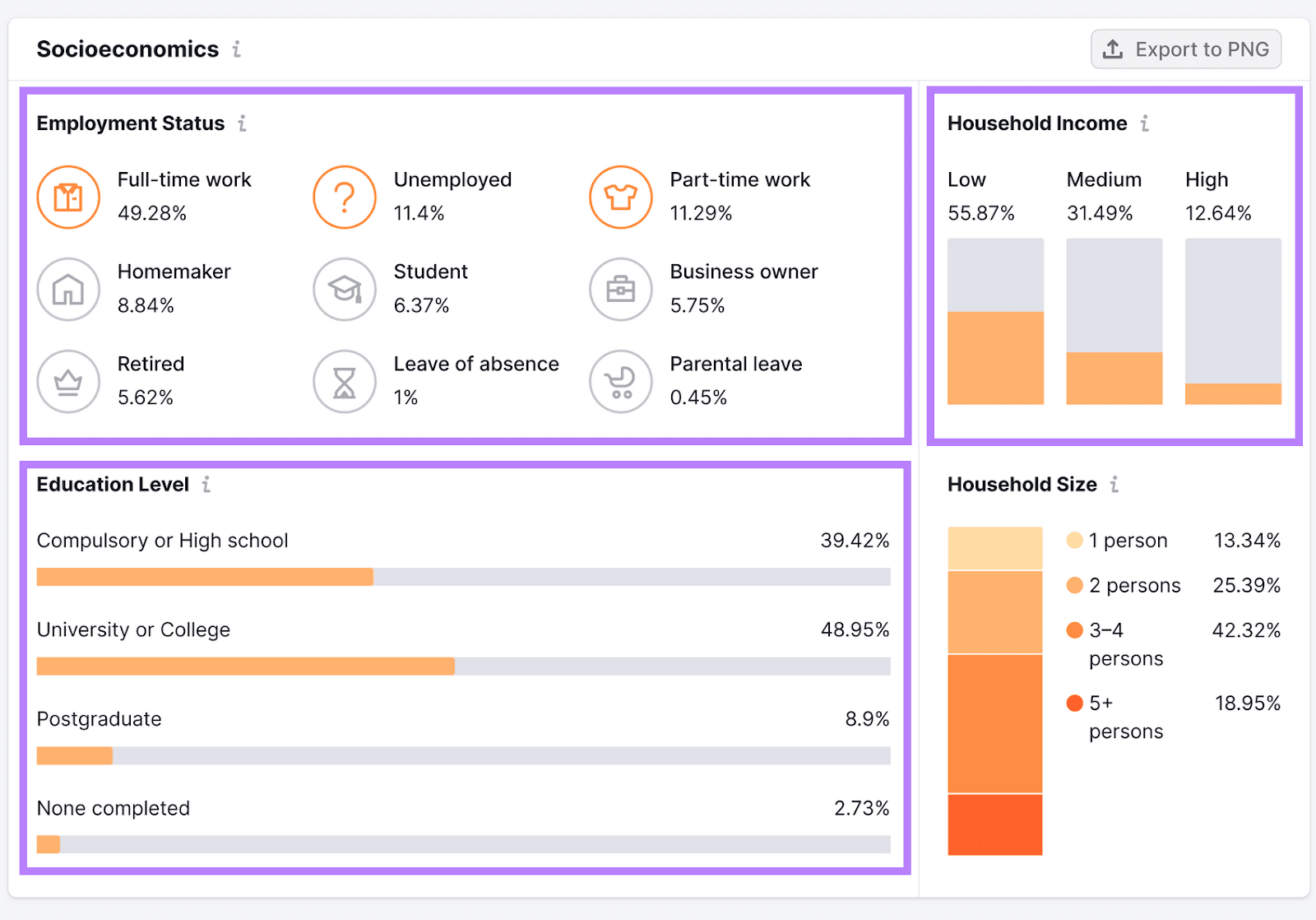
Analyze this information to select the right channels for your marketing campaign, and craft your marketing assets to resonate with the audience.
Say you run a travel business. This socioeconomic data shows that most men interested in travel are employed full time. You might assume they only get a few weeks off per year.
You can also see their average incomes. Using this information, craft travel packages that help them maximize their limited time at a destination within their budgets.
Scrolling farther down will also give you a list of websites your target audience visits. Establish partnerships with these brands to broaden your reach.
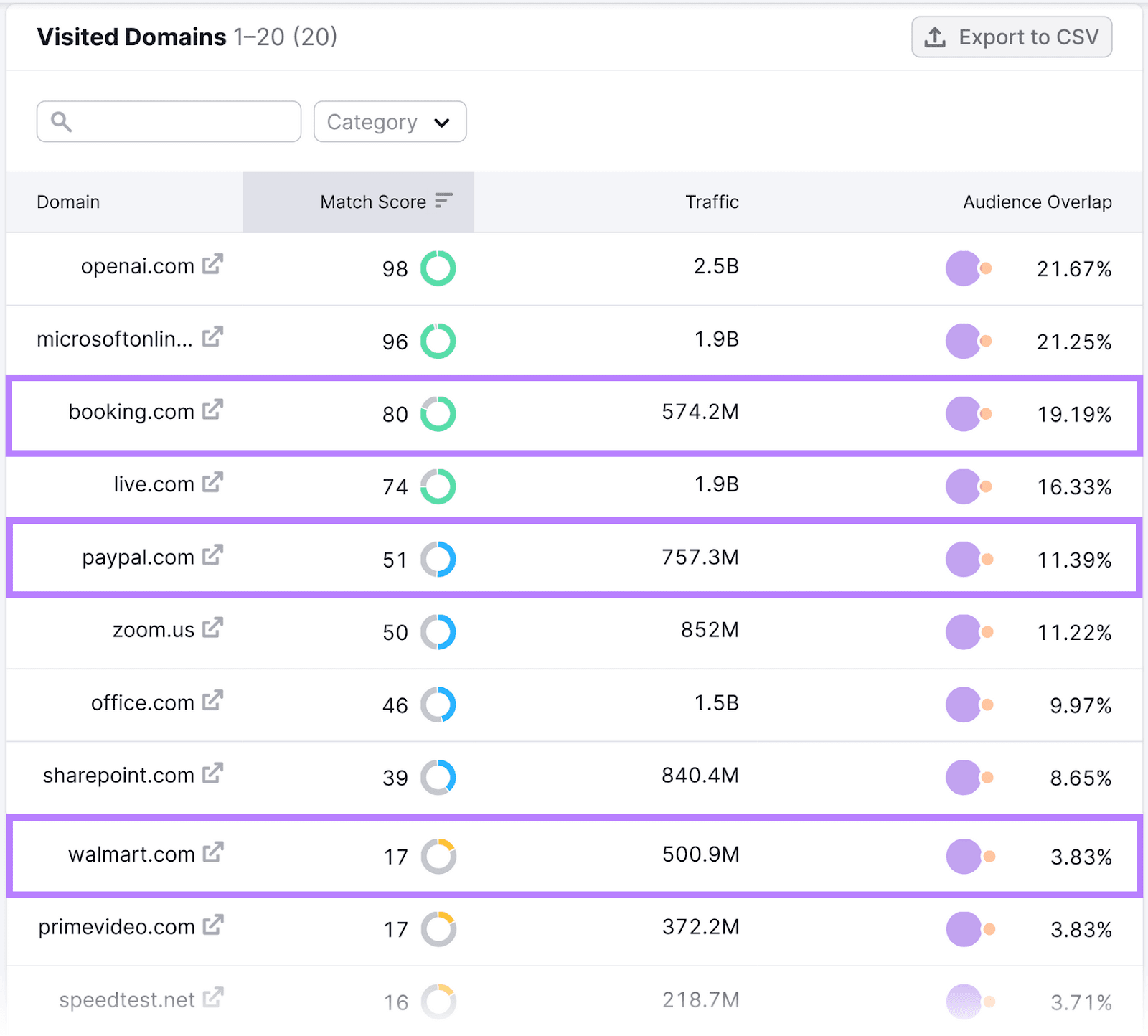
For further insights, see our guide on how to do digital marketing competitor analysis with Semrush.
2. Set Strategic Goals
Use the SMART (Specific, Measurable, Actionable, Relevant, and Timebound) framework to create a roadmap for your campaign.
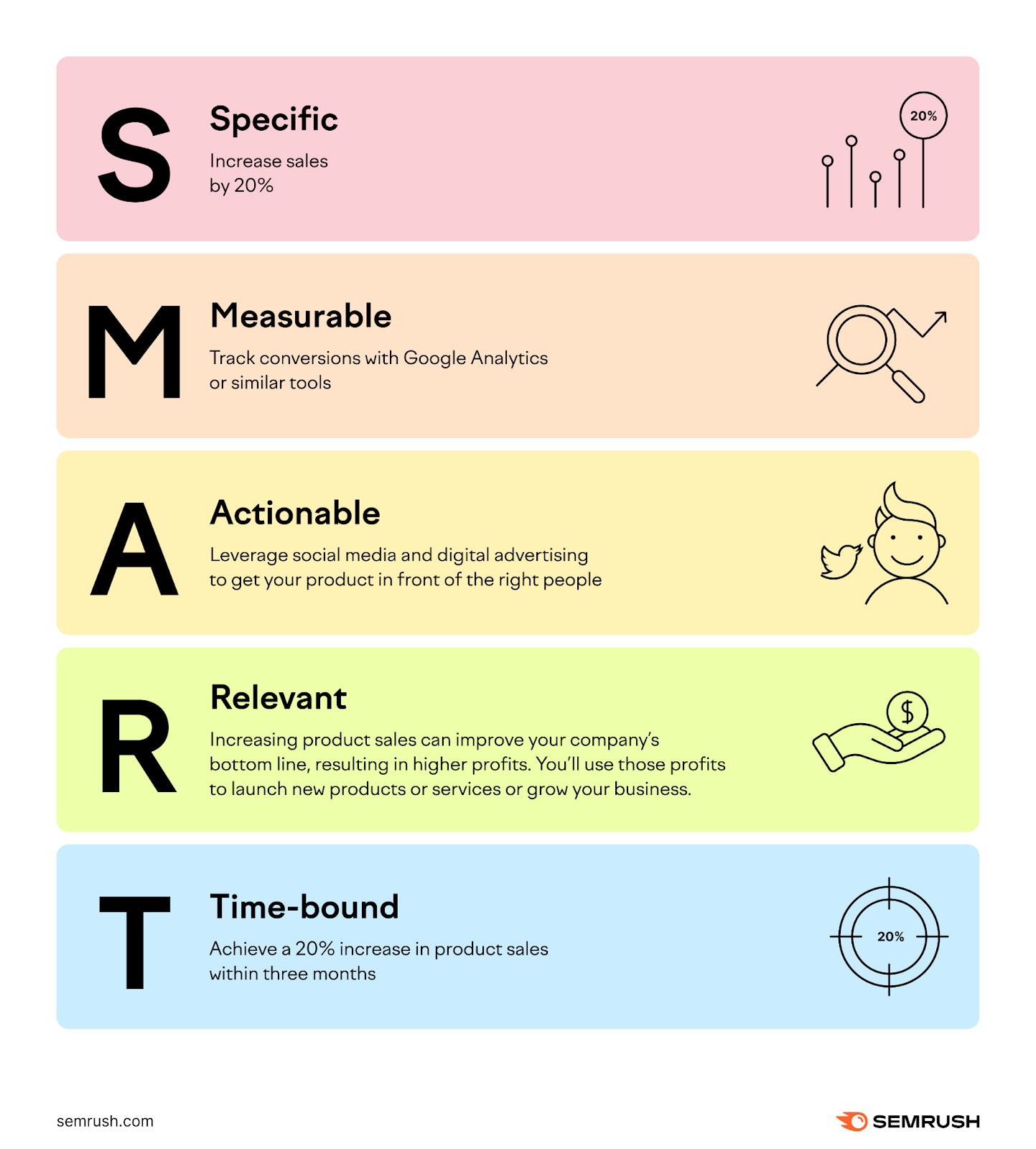
Let’s assume you operate a fitness company called "FitNow” and just released a high-performance workout shirt.
Based on the SMART framework, your goals should be:
- Specific: Increase sales by 20%.
- Measurable: Track conversions with Google Analytics or similar tools.
- Actionable: Leverage social media and digital advertising to get your product in front of the right people.
- Relevant: Increasing product sales can improve your company’s bottom line, resulting in increased profits.
- Time-bound: Achieve a 20% increase in product sales within three months.
So, FitNow's SMART goals are:
Sell 20% more t-shirts within the next three months by implementing a marketing strategy using social media and paid ads. You’ll track sales volume, conversions, and ROI with Google Analytics.
3. Financial Planning
Next, create a budget for your campaign—a benchmark to measure the results over time.
For instance, you could compare the costs of the campaign vs. the profits generated to decide whether it had a good ROI.
There’s no clear answer to how much you should allocate for a campaign, as that varies by industry, location, and company revenue.
Most companies spend about 9.1% of their revenue on marketing. Use that as a reference, and decide what makes sense for your business.
Here’s what you need to do to budget for your campaign:
- Identify fixed costs: Define key expense categories such as advertising, content creation, and promotional activities. Set a spending limit for each of these per month or quarter. Factor in the costs of any outside hires, too.
- Allocate additional funds for variable costs: Things can go wrong during a campaign. Maybe your ad manager forgets to turn off a seasonal ad, or your website breaks down. You can deal with these situations quickly if you allocate some extra money for unexpected costs.
- Adjust spend per channel based on data: As an example, start by allocating 80% to SEO and 20% to ads. Later, invest more money in one channel if it consistently performs better than the other. Keep track of this data and adjust accordingly.
4. Select the Right Marketing Channels for Maximum Reach
Use the Market Explorer tool to discover where your target audience spends most of its time online. That’s where you’ll focus your campaign.
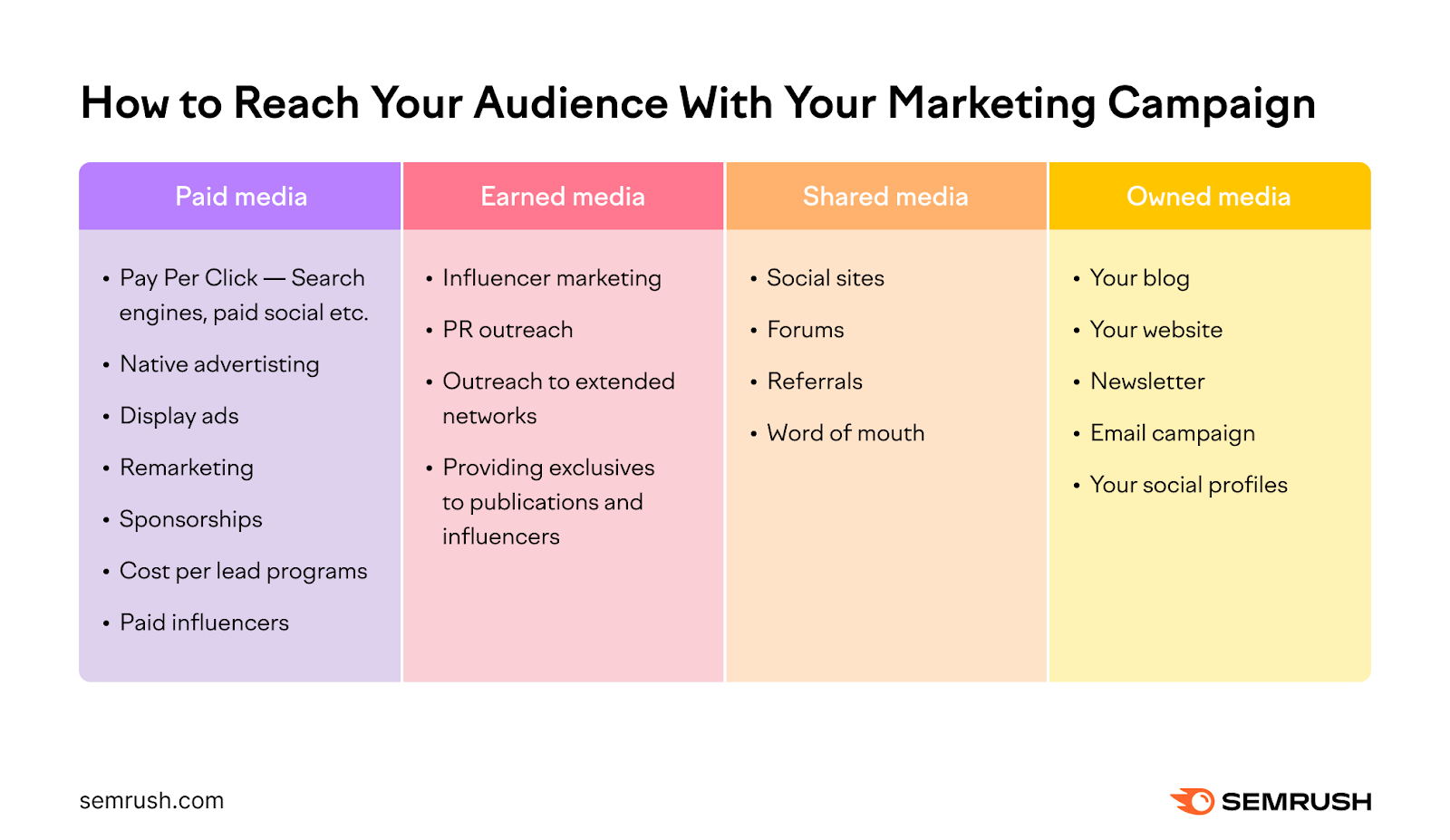
Are you using all your competitors' marketing channels? Test digital channels you don't use but your competitors do.
Further reading: Marketing Channel Strategy 101: Everything You Need to Know
5. Create Content to Engage Your Audience
Pay attention to what your audience looks for on social media or in search engines. Consider the language they use to find what they want.
Semrush’s Keyword Magic Tool identifies the search terms consumers type in their browsers to find products, services, or information online. Also known as keywords.
Use this data to create articles, blog posts, and visual content that appeals to your customer base. Consider their needs, preferences, and pain points—and set clear goals for each piece of content.
If, say, you sell software programs, create demo videos to show your products in action. Write blog posts about their features, share tips on social media, and publish case studies to prove your point (e.g., “How [Product Name] Helped a Dental Practice Get 30% More Patients”).
Further reading: How to Use Semrush for Keyword Research
6. Timing and Scheduling for Impactful Delivery
The ideal time to start the campaign depends on your marketing goals.
For example, if your goal is to increase Black Friday sales, you’ll launch a short-term campaign a few days or weeks before the big day.
You could roll out a long-term campaign as soon as your business starts generating revenue. Marketing is one of the primary drivers of business growth, so any company can benefit from running ongoing campaigns focused on broad goals like brand awareness and sales.
Another good time to start a campaign is when you're ready to scale your business or enter new markets.
Adjust the strategies you deploy based on your budget, goals, and target audience. Use our marketing calendar guide and templates to plan your content for each marketing channel.

7. Track Campaign Performance
Assign a KPI that measures the campaign's overall success. For example, FitNow’s KPI was a “20% increase in sales."
Assign metrics to each channel or marketing asset, and compare them over time to gauge their effectiveness.
FitNow could track the following:
- Content marketing metrics: Blog post views, video watch time, and social media interactions. These metrics align with FitNow's goal of a 20% increase in product sales.
- Social media metrics: Shares, engagement, and impressions indicate an interest in your business. They may contribute to brand awareness and boost website traffic.
These metrics show FitNow what to improve.
If your social media engagement rate is low compared with the previous month, it could mean your content isn’t resonating with its audience. Consider trying new trends to engage more audiences.
Here are the metrics you can track for each channel:
| Type of Content | Metrics to Track |
| Email Metrics |
|
| Social Media (Paid) Metrics |
|
| Social Media (Organic) Metrics |
|
| Lead Magnet/Content Offer Metrics |
|
| Displav Ads/Paid Media Metrics |
|
| Content/SEO Metrics |
|
| Direct Mail Metrics |
|
8. Fine-Tune Your Marketing Campaign and Identify Areas for Improvement
Compare your campaign data against your KPIs and goals. Your findings should highlight the following aspects related to the campaign:
- Main successes
- Primary challenges
- Primary failures
- Other key observations, such as factors that could have influenced your success or failures
Based on these findings, draft a plan for improving the campaign (and any future campaigns).
For example, Facebook performed better than Instagram or X. So you plan to make Facebook your primary channel for a similar upcoming campaign.
Further reading: 16 Marketing KPIs You Need to Monitor in 2024
Use the Right Marketing Tools to Get Better Results
Marketing campaigns require a substantial amount of thought, time, and resources.
Leverage technology to streamline your work. Here are a few Semrush tools to elevate your marketing campaign strategy and planning process:
Campaign Planning:
- Traffic Analytics guides KPIs and metrics based on competitive analysis;
- Market Explorer provides deep insight into target niches so you can better understand the audience you’re trying to reach;
- Topic Research suggests ideas for your content and uncovers trending topics that people search for online.
- AI Marketing Strategy offers a library of marketing tactics and frameworks to follow for every step of the marketing funnel. Plus AI tools to help with content creation.
Campaign Preparation and Implementation:
- SEO Content Template generates an SEO content brief with recommended text length, readability score, semantically related keywords, potential backlink targets, and more based on your seed keyword;
- SEO Writing Assistant allows you to check the SEO potential, readability, and originality of a piece of content in real time;
- Keyword Magic Tool gives you access to an extended database with over 25.5 billion keywords;
- Social Toolkit offers a simple way to draft, schedule, and post content on Facebook (business pages), LinkedIn, Instagram, Google Business Profile, Pinterest, and X.
Campaign Tracking and Analysis:
- Site Audit analyzes your website to identify potential issues that may affect your search engine rankings.
- My Reports makes it easy to integrate reports from dozens of Semrush tools, Google Analytics, Google Search Console, Google Business Profile, and screenshots and images to create professional marketing performance reports.
Sign up for a free trial today to access these tools and many more.
This post was updated in 2024. Excerpts from the original article by Victoria Liaonenka may remain.
